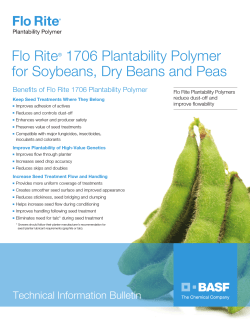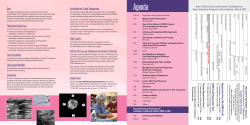
Document 123228
341 Christian Street, Oxford, CT 06478 USA Tel: (203) 267-6061 Fax: (203) 267-6065 www.naturalsourcing.com info@naturalsourcing.com MATERIAL SAFETY DATA SHEET GRAPEFRUIT SEED EXTRACT MSDS 1. PRODUCT NAME AND COMPANY IDENTIFICATION Product Name: GRAPEFRUIT SEED EXTRACT Product Use: Personal Care Formulations Company Name: Natural Sourcing Company Address: 341 Christian Street, Oxford, CT 06478, USA Date Issued: 03/03/2014 Emergency Telephone Number: Chemtrec Tel: (800) 262-8200 2. COMPOSITION/INGREDIENT INFORMATION Chemical Family: Bioflavonoids / Ascorbics CAS No: 84696-38-8; 90045-43-5 Citrus Grandis Extract: 90045-43-5 Ascorbic Acid: 50-81-7 Glycerin: 56-81-5 Grapefruit Seed Extract Components: CTFA/INCI Name: Chemical Formula: Active Ingredients Grapefruit Seed Extract Vitamin C (Ascorbic acid) 60% active/40% inert Inert Ingredients Glycerin (USP 97.7 and kosher) Moisture 37.0-40.0% 0.0- 3.0% (max) 40.0% 100.0% Hazard Classification (99): % TLV Not applicable 0 N/A 40%-45.0% 15%-20.0% (max) (primary source of Vitamin C is from the extract) 60.0% 3. HAZARDS IDENTIFICATION Inhalation: If ingested, drink large quantities of water or milk. Do not induce vomiting. Avoid contact with eyes. Likely to cause severe eye irritation. Avoid prolonged contact at full strength due to low pH of product. May cause skin irritation. Avoid breathing vapour when heating. Ingestion: DO NOT INGEST. NOT FOR HUMAN CONSUMPTION. Emergency Overview: Eyes: Skin: Page 1 of 4 4. FIRST AID MEASURES Eyes: Skin: Ingestion: Inhalation: Medical Conditions Generally Aggravated by Exposure: Flush eyes with water for at least 15 minutes. Seek medical attention immediately. Wash skin with soap and water. Rinse skin thoroughly with water for at least 15 minutes. DO NOT INDUCE VOMITING! Give milk and / or egg white beaten in water. Avoid all alcohol. Call a physician at once. Remove from contaminated area to fresh clean air. None 5. FIRE FIGHTING MEASURES Flash Point (Method Used): 292˚F Flammable Limits LEL: Not Established UEL: Not Established Extinguishing Media: Foam, Water Fog, Carbon Dioxide, or Dry Chemical Water of foam may cause frothing, which can be violent and possibly endanger the life of the fire-fighter, especially if sprayed into containers of hot, burning liquid. Wear self-contained breathing apparatus with a full-face piece operated in the positive pressure demand mode when fighting fires. Never use welding or cutting torch on / near drum. Residue may ignite. Special Firefighting Procedures: Unusual Fire & Explosion Hazards: Hazard Thermal Decomposition Products: Not known 6. ACCIDENTAL RELEASE MEASURES (STEPS FOR SPILLS) Personal Precautions: Wear protective gloves, aprons, and chemical splash goggles. Environmental Precautions: Advise authorities if product enters sewers. Avoid contacting other materials. All spills should be absorbed with sawdust, sand, paper towels, or an equivalent absorbent. The absorbent materials should then be removed and incinerated. Final treatment of the area should be cleaned with soap and water. Do not spill into water stream. This product, at full strength, is toxic to fish. Methods for Cleaning Up: 7. HANDLING AND STORAGE Handling Safe Handling: Wear protective gloves and aprons. Chemical splash goggles are recommended. Clean contaminated equipment thoroughly. Storage Requirements for Storage Areas and Containers: Other: Store in cool, dry well ventilated storage area. Non-corrosive liquid. 8. EXPOSURE CONTROL/PERSONAL PROTECTION Chemical splash goggles in compliance with OSHA regulations are Eye: advised. Skin/Body: Wear resistant gloves such as; natural rubber & protective aprons. Page 2 of 4 Other: A NIOSH / MSHA approved air supplied respirator is advised if prolonged exposure without proper ventilation is unavoidable. OSHA regulations also permit other NIOSH / MSHA respirators (negative pressure type) under specified conditions (see your safety equipment supplier). Engineering or administrative controls should be implemented to reduce exposure. Provide sufficient mechanical (general and / or local exhaust) ventilation to avoid unhealthy exposure. Evaluate need based on application. Work/Hygiene Practice: N/A Respiratory: Ventilation: 9. PHYSICAL AND CHEMICAL PROPERTIES Physical State: Heavy, viscous liquid Color: Yellow to golden brown Odor: Mild citrus pH: (10% solution) 1.5-3.0 Vapor Pressure (mm Hg.): N/A Vapor Density (AIR = 1): 4.1 Freezing Point: 20.0°F/-6.67˚C Melting Point: N/A Specific Gravity: (@25°C) 1.10-1.30 Solubility in Water: Soluble Volatile: Non-Volatile 10. STABILITY AND REACTIVITY Stability: Stable under normal conditions Incompatibility (Materials to Avoid): Strong oxidising agents Hazardous Decomposition or Byproducts: Polymerization will not occur Conditions to Avoid: Extreme Heat 11. TOXICOLOGICAL INFORMATION OSHA TLV: N/A ACCIN TLV: N/A Carcinogen NTP: No ARC: No OSHA: Toxicity: (*conducted during product development only) No Skin: Sensitivity: Symptoms of Exposure: • Acute oral LD50 in white rats 5,000 mg/kg • Acute inhalation LC50 in rabbits and guinea pigs at 250 mg m3 slight increase in serum alkaline phosphate levels. • Irritant when tested according to method 16CFR 1500.41 • (Does) meet the criteria to corrosiveness 49CFR 173.240 (a) (1) • (Does Not) produce allergic sensitisation in a substantial number of people. • Severe eye irritation and mucous irritation when used directly. 12. ECOLOGICAL INFORMATION Ecotoxicity: Do not spill into water stream. This product, at full strength, is toxic to fish. Page 3 of 4 Environmental Fate: Based largely or completely on information for primary material (glycerin). Biodegradable under aerobic conditions. Biodegradation is expected to be acheivable in a secondary wastewater treatment plant. 13. DISPOSAL CONSIDERATIONS Grapefruit Seed Extract is classified as a non-corrosive liquid and should be disposed of in accordance with all local, state, and federal regulations. Do NOT allow entry into sewers or any body of water. Waste Disposal Methods: For unused and uncontaminated product: The preferred options include sending to a licensed, permitted: Recycler, Reclaimer, Incinerator or other Thermal Destruction Device. 14. TRANSPORT INFORMATION DOT Classification: IATA Classification: Proper Shipping Name: For DOT regulatory information, if required, consult transportation regulations or product shipping papers. For IATA regulatory information, if required, consult transportation regulations or product shipping papers. Non-corrosive liquid, Hazard class 15. REGULATORY INFORMATION ATF Distilled Spirits Act Environmental Lists: Not Applicable State Lists: (Not meant to be all-inclusive. Selected regulations represented) Notice: 16. ADDITIONAL INFORMATION The complete range of conditions or methods of use are beyond our control therefore we do not assume any responsibility and expressly disclaim any liability for any use of this product. Information contained herein is believed to be true and accurate however, all statements or suggestions are made without warranty, expressed or implied, regarding accuracy of the information, the hazards connected with the use of the material or the results to be obtained from the use thereof. Compliance with all applicable federal, state, and local laws and local regulations remains the responsibility of the user. This safety sheet cannot cover all possible situations which the user may experience during processing. Each aspect of your operation should be examined to determine if, or where, additional precautions may be necessary. All health and safety information contained in this bulletin should be provided to your employees or customers. Page 4 of 4
© Copyright 2025





















